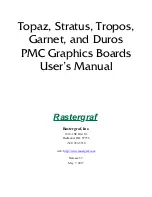
29
Pipeline
In relation to computer graphic processors, refers to the number of separate
arithmetic units available for rendering the output on a display. In general,
more pipelines available on a graphical processor means there are more 3D
rendering capabilities available, increasing overall 3D performance.
Pixel Tapestry™
Pixel Tapestry™ is a graphics architecture that includes multiple
independent texture units for each rendering pipeline. This technology
makes 3D surfaces look more realistic and detailed.
Pixel Tapestry™ II
Pixel Tapestry™ II uses four parallel, highly optimized rendering
pipelines, each capable of handling two textures simultaneously. It
provides advanced texturing, making 3D surfaces look more detailed and
realistic.
Refresh Rate
Also referred to as “vertical refresh rate.” This is the rate at which a monitor
or television can redraw the screen from top to bottom. NTSC television
systems have a refresh rate of approximately 60 Hz whereas computer
displays typically have refresh rates of 75 Hz or more. At refresh rates of
70 Hz and lower, screen flicker is often noticeable.
Rendering
Rendering refers to the final drawing stages where the 2D image that
appears on a display is derived from its 3D descriptions. What appears on
the display may look three dimensional, but it is really just a 2D grid of
pixels designed to appear that way.
Resolution
The resolution of any display is the number of pixels that can be depicted
on screen as specified by the number of horizontal rows against the number
of vertical columns. The default VGA resolution of many video cards is
capable of displaying 640 rows of pixels by 480 columns. The typical
Содержание RADEON X1900 G5
Страница 1: ...ATI RADEON X1900 G5 MAC EDITION User s Guide P N 137 41055 10...
Страница 4: ...iv Index 35...
Страница 8: ...4 TV Out Support...
Страница 44: ...40...












































